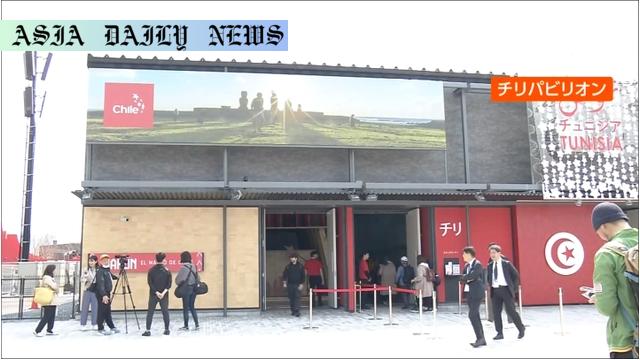Expo Pavilions: Brazil and Chile delight visitors with captivating displays demonstrating cultural heritage and innovation.
Brazil and Chile opened their Expo 2025 pavilions three days after the event started.
Brazil’s pavilion showcases art using recycled materials, blending Brazilian and Japanese traditions.
Chile’s pavilion features an intricate textile piece created by 200 indigenous women, highlighting cultural craftsmanship.

Brazil and Chile Open Their Expo 2025 Pavilions
The 2025 World Expo in Osaka welcomed an exciting addition as Brazil and Chile officially unveiled their pavilions three days after the event began. These two countries overcame preparatory delays to bring forth stunning representations of their cultural heritage and sustainable artistry, delighting visitors from around the globe. Such showcases are instrumental in fostering global appreciation for diverse traditions, creative enterprise, and the environmental message that resonates deeply today.
Brazil’s Pavilion: Sustainable Art and Cultural Fusion
Brazil’s pavilion is a remarkable exhibit that blends art with eco-consciousness. The display’s centerpiece is a creative assortment of objects shaped like humans and animals, skillfully crafted from plastic bags and other recycled materials. This not only draws attention to sustainability but also represents the soulful artistry deeply ingrained in Brazilian culture.
Adding a participative element to the experience, visitors are provided with free capes, known as Parangoles, which combine traditional Japanese and Brazilian designs. These capes are not only stylish but encourage visitors to immerse themselves in a tactile and exciting cultural exchange. For instance, an elementary school student from Osaka remarked that wearing the vibrant orange Parangole made her feel as though she was dancing, highlighting the creative impact on visitors of all ages.
Chile’s Pavilion: Indigenous Craftsmanship and Cultural Identity
The Chilean pavilion, on the other hand, takes visitors on a journey into the heart of indigenous craftsmanship. Its signature feature is a breathtaking textile installation—a vividly colorful tapestry draped over a 13-meter-long wooden structure. This artwork was lovingly created by 200 indigenous women using traditional methods of wool dyeing and weaving. The geometric designs, featuring flowers and celestial motifs, reflect the profound connection between Chile’s indigenous people and nature.
According to a representative from the Chilean government, the exhibit required over a year of meticulous effort to bring to life. Their dedication paid off as visitors are now moved by the depth of cultural heritage and the storytelling woven into every thread. The pavilion not only serves as an artistic statement but as an educational space where attendees can learn about Chile’s traditions and the resilience of its people.
The Impact of Cultural Displays at Global Events
Brazil and Chile’s pavilions at Expo 2025 exemplify the power of cultural showcases in fostering global unity and understanding. As visitors engage with these art installations, they are drawn into narratives that reveal the unique similarities and shared values across diverse communities. Moreover, by emphasizing sustainability and indigenous heritage, both nations have underlined their commitment to redefining the global outlook on culture and innovation.
Events like Expo 2025 provide an invaluable platform for countries to connect with a worldwide audience, celebrating the rich tapestry of human creativity while addressing contemporary issues like environmental responsibility. Brazil and Chile’s pavilions, with their inspiring creativity and cultural depth, will undoubtedly leave a lasting impression on all who visit.



Commentary
The Significance of Cultural Pavilions in Global Expositions
Cultural pavilions have always been vibrant highlights of global expositions, serving as a window to the soul of a nation. Brazil and Chile’s contributions to Expo 2025 exemplify this enduring tradition, combining artistic expression with poignant messages about sustainability and heritage. These efforts are timely and vital in today’s interconnected yet culturally fragmented world.
Brazil’s Sustainable Message Through Art
Brazil’s innovative use of recycled materials in its pavilion art is a striking reminder of the need to harmonize tradition with sustainability. More than just an aesthetic choice, this decision underscores the importance of rethinking resource consumption. Furthermore, the inclusion of Parangoles—stunning symbols of cultural fusion—demonstrates a unique way to merge two different traditions, inviting people to participate in an artistic experience that transcends cultural boundaries.
Celebrating Chile’s Indigenous Artisans
Chile’s pavilion, with its intricate textile art, provides a platform for indigenous women whose heritage often goes underappreciated on the global stage. Their commitment to preserving their ancestral techniques highlights the need to protect intangible cultural heritage in an era of standardization. The exhibit not only fascinates with its visual appeal but it also educates visitors about the ongoing relevance of indigenous craftsmanship in contemporary society.
Global Unity Through Cultural Events
Events like Expo 2025 serve as bridges, connecting audiences from around the world to the heart of diverse nations. Brazil and Chile’s pavilions exemplify how cultural displays can transcend language, geography, and politics. These showcases are not mere temporary attractions—they are building blocks for a more empathetic, globally informed world.
In conclusion, the success of these two pavilions highlights the essential role of cultural diplomacy in international events. Brazil and Chile have masterfully demonstrated that through art, nature, and storytelling, it’s possible to inspire change and foster connections that resonate far beyond the walls of their exhibitions.